Swimming is a great exercise and activity for dogs of all ages, sizes and breeds. It can improve their physical health, mental well-being and overall happiness.
But did you know that swimming underwater can offer even more benefits for your furry friend? Underwater swimming can enhance your dog’s strength, endurance, agility and confidence.
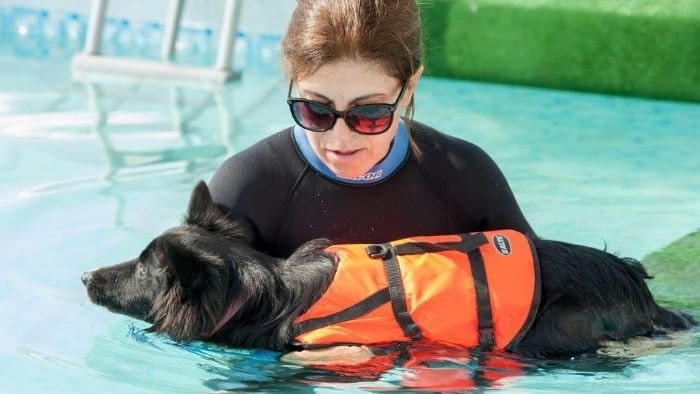
It can also provide a stimulating and rewarding challenge for your dog’s mind and senses. However, teaching your dog to swim underwater is not as easy as it sounds. It requires patience, preparation and proper guidance.
In this article, we will show you how to teach a dog to swim underwater, how to prepare your dog for underwater swimming, and how to make it a fun and safe experience for both of you.
Contents
Steps on How to Teach a Dog to Swim Underwater?
For dogs, swimming underwater is a fun and difficult sport that may enhance both their physical and emotional health. To make it safe and fun, though, some training and preparation are needed.[1]
The steps for how to teach a dog to swim underwater are listed below:
Step #1: Get Your Dog Comfortable With Water
Getting your dog used to water in general is the first step in teaching them to swim underwater. Your dog will develop a good relationship with water and be able to overcome any fear or anxiety thanks to this.

Here are some advice on introducing your dog to water gradually, using rewards and positive reinforcement, and avoiding typical blunders and hazards:
a). Introduce your dog to water gradually:
- Start with a calm, shallow and safe body of water, such as a kiddie pool, a bathtub, or a small pond. Avoid deep, fast-moving or cold water that can scare or harm your dog.
- Let your dog explore the water at their own pace. Don’t force or push them into the water. You can walk parallel to the water and let your dog follow you or gravitate towards the water when they feel comfortable.
- Use a toy or a treat to lure your dog into the water. Toss the toy or treat just far enough to require your dog to get their paws wet. Gradually increase the distance and depth as your dog becomes more confident.
- Stay close to your dog and provide verbal praise and encouragement. You can also join your dog in the water or let them watch another dog swim to show them that water is fun.
b). Use positive reinforcement and rewards:
- Reward your dog for every small step they take towards the water or in the water. Use treats, toys, affection or whatever motivates your dog.
- Avoid scolding, punishing or yelling at your dog if they are hesitant or nervous. This will only make them more fearful and resistant.
- Make the water play session short and enjoyable. End on a positive note and leave your dog wanting more.
c). Avoid common mistakes and risks:
- Check the water quality and temperature before letting your dog swim. Avoid water that is polluted, contaminated, too hot or too cold.
- Equip your dog with proper gear and accessories for swimming, such as a life jacket, a leash, goggles or ear plugs if necessary.
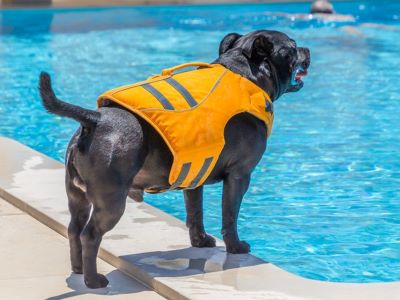
- Monitor your dog’s breathing, body language and energy level while swimming. Don’t let them overexert themselves or swallow too much water.
- Rinse your dog off after swimming and dry them thoroughly. Check their ears, eyes, nose and mouth for any signs of irritation or infection.
Step #2: Teach Your Dog to Submerge Their Head
Teaching your dog to dive beneath water is the second stage in teaching them to swim. This will help your dog become accustomed to the sensation of being underwater and make them ready for longer dives.
Here are some pointers for luring your dog underwater with a toy or reward, keeping an eye on your dog’s respiration and body language, and prolonging and deepening the immersion:
a). Use a toy or a treat to lure your dog underwater:
- Choose a toy or a treat that your dog loves and that is waterproof. You can use a frisbee, a ball, a bumper or a kibble.
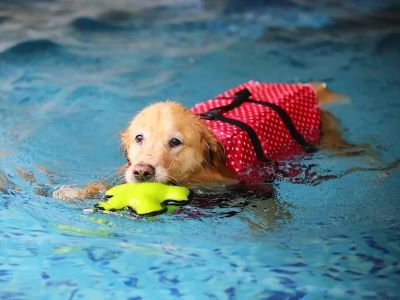
- Hold the toy or treat in front of your dog’s nose and slowly lower it into the water. Encourage your dog to follow it with their eyes and nose.
- When the toy or treat is just below the surface, gently push your dog’s head into the water. Praise and reward your dog for submerging their head.
- Repeat this process until your dog can submerge their head willingly and comfortably. You can also join your dog in the water and show them how to do it.
b). Monitor your dog’s breathing and body language:
- Watch your dog’s breathing pattern and rate before, during and after submerging their head. Your dog should be able to hold their breath for a few seconds without difficulty.
- Observe your dog’s body language and facial expression while underwater. Your dog should look relaxed and curious, not tense or scared.
- If your dog shows any signs of distress, discomfort or panic, such as coughing, gagging, whining, shaking or trying to escape, stop the training immediately and comfort your dog.
c). Increase the duration and depth of submersion:
- You may progressively increase the length and depth of submersion once your dog can do so with ease. This may be accomplished by holding the treat or toy farther away from your dog or deeper into the water.
- To tell your dog to dive underwater, you may also use a cue phrase or a hand motion. Before dropping the toy or food into the water, you may, for instance, say “dive” or point below.
- Reward your dog whenever it emerges from the water. To make underwater swimming for your dog more fascinating and demanding, you may change the setting and situation.
Step #3: Train Your Dog to Follow Your Lead
Establishing a clear communication system with your dog utilizing voice orders, hand gestures, and whistles will enable you to swim underwater together.
Dogs are able to comprehend human speech in a manner that no other animal can, but they must first be taught what each cue means.
A full-face dive mask with a speech system is another choice for communicating with your dog while diving, but it’s optional and not always accessible or economical.
a). Teach your dog voice commands: Vocal commands may be used to gain your dog’s attention and provide orders. Anything goes as long as it’s brief, understandable, and consistent.
You can utilize words like “stay,” “come,” “down,” “up,” “left,” “right,” etc. To teach your dog a vocal command, use the following actions:
- Demonstrate and say the command to your dog.
- Reward your dog for obeying the command.
- Increase the challenge of the command.
- Generalize the command to different contexts.
b). Teach your dog hand signals: When your dog can’t hear you or you want to be discrete, hand signals can help you communicate with them. All motions are acceptable as long as they are easy to understand, distinct, and visible.
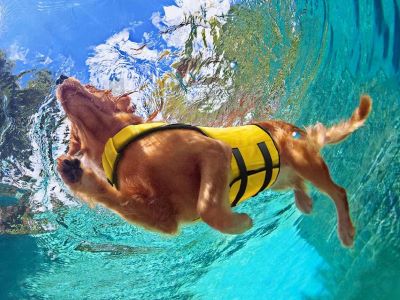
You can employ gestures like pointing, waving, giving the thumbs up or down, etc. The instructions below can be used to teach your dog a hand signal:
- Pair the hand signal with the voice command.
- Reward your dog for obeying the hand signal.
- Eliminate the voice command and use only the hand signal.
- Generalize the hand signal to different contexts.
c). Teach your dog whistle signals: Whistle signals can be used to communicate with your dog when you’re far away or there’s a lot of background noise.
Any whistle will do as long as it is audible and loud. Moreover, different whistling patterns can be used to send various meanings.
A single short whistle can be used for “stop,” two short whistles for “come,” a single lengthy whistle for “stay,” etc. The steps below can be used to teach your dog the whistle signal:
- Pair the whistle signal with the voice command.
- Reward your dog for obeying the whistle signal.
- Eliminate the voice command and use only the whistle signal.
- Generalize the whistle signal to different contexts.
- Mix and match the signals to communicate better underwater.
d). Teach your dog to stay close to you and follow your direction under water: To swim underwater with your dog safely and smoothly, you need to teach your dog to stay close to you and follow your direction under water.
This will help you avoid losing sight of each other or getting into trouble. To teach your dog this skill, follow these steps:
- Begin in shallow water with goggles and snorkel.
- Tell your dog to stay by your side and reward them.
- Move forward in the water with your dog and reward them.
- Increase the speed and distance of your movement and reward your dog.
- Change your direction in the water with signals and reward your dog.
- Increase the difficulty and complexity of your direction changes and reward your dog.
Advantages of Teaching a Dog to Swim Underwater
- Dogs can benefit from swimming underwater as a low-impact, all-body exercise that builds muscle and enhances cardiovascular health.[2]
- Your dog’s intellect and senses may be stimulated while swimming underwater as they explore a new environment and pick up new abilities.
- Both you and your dog may find swimming underwater to be enjoyable and gratifying as you get closer over a shared task and share a love of the water.
Challenges and Risks of Teaching a Dog to Swim Underwater
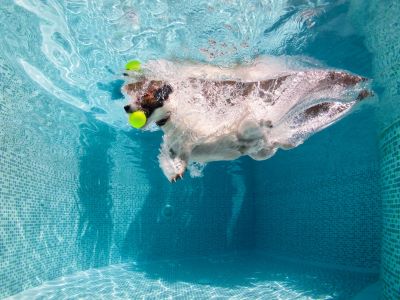
- Not all dogs are natural swimmers or divers. Some breeds may have more difficulty staying afloat or submerging their head due to their body structure, coat type or temperament.
- Teaching a dog to swim underwater requires patience, preparation and proper guidance. You need to introduce your dog to water gradually, use positive reinforcement and rewards, and avoid forcing or scaring your dog.
- Swimming underwater can also pose some potential hazards for your dog, such as drowning, hypothermia, ear infections, water intoxication or ingestion of harmful substances.
Tips for Teaching a Dog to Swim Underwater
- Check the water quality and temperature before letting your dog swim. Avoid water that is polluted, contaminated, too hot or too cold.
- Equip your dog with proper gear and accessories for swimming, such as a life jacket, a leash, goggles or ear plugs if necessary.
- Monitor your dog’s breathing, body language and energy level while swimming. Don’t let them overexert themselves or swallow too much water.
- Rinse your dog off after swimming and dry them thoroughly. Check their ears, eyes, nose and mouth for any signs of irritation or infection.
- Start with shallow water and short sessions. Use a toy or a treat to lure your dog underwater. Praise and reward your dog for submerging their head.
- Gradually increase the depth, distance and duration of underwater swimming. Use a cue word or a hand signal to indicate when you want your dog to go underwater.[3]
- Vary the location and scenario of underwater swimming to make it more interesting and challenging for your dog.
FAQs
Can all dogs swim underwater?
Not all dogs can swim underwater, as their comfort and abilities in the water may vary. Consider your dog’s individual characteristics when introducing them to underwater swimming.
What helps a dog to swim in water?
Dogs can swim due to their natural instincts and physical characteristics such as webbed paws and a streamlined body. However, not all dogs are natural swimmers.
Can you teach dogs to dive?
Teaching dogs to dive underwater can be challenging and requires specialized training techniques. It is important to prioritize the safety and comfort of the dog during the training process.
How do you teach a dog to swim without splashing?
To teach a dog to swim without splashing, start with calm water and gradually introduce the dog to swimming using positive reinforcement. Avoid activities that cause excessive splashing initially and gradually introduce controlled splashing as the dog becomes more confident.
Conclusion
Underwater swimming for dogs offers a range of benefits, including exercise, cardiovascular health, mental stimulation, and cooling off during hot weather.
While dogs may not be adapted for prolonged underwater swimming, their natural instincts and physical attributes enable them to navigate through water.
To ensure safe and enjoyable underwater swimming, it’s important to gradually introduce your dog to water, use positive reinforcement, and prioritize their safety.
Seeking professional guidance for advanced diving techniques is recommended. The conclusion emphasizes starting small, building confidence, and fostering a stronger bond.
By following precautions and prioritizing their dog’s well-being, owners can create rewarding and memorable experiences in the water.
References:
- Poole, D. C., Copp, S. W., Colburn, T. D., Craig, J. C., Allen, D. T., Sturek, M., O’Leary, D. S., Zucker, I. H., & Musch, T. I. (2020). Guidelines for animal exercise and training protocols for cardiovascular studies. American Journal of Physiology, 318(5), H1100–H1138. – American Journal of Physiology
- Nganvongpanit, K., Tanvisut, S., Yano, T., & Kongtawelert, P. (2014). Effect of Swimming on Clinical Functional Parameters and Serum Biomarkers in Healthy and Osteoarthritic Dogs. ISRN Veterinary Science (Print), 2014, 1–8. – Hindawi
- Wilkinson, J., & Wilkinson, J. (2022). How to Teach a Dog to Swim Underwater? DogLovesBest

Dania is a dog groomer living in California, who loves styling dogs. She often uses dog accessories to keep them distracted while grooming. She is also a dog parent to a Pomeranian, Duke. It’s because of him she is always on a lookout for the best dog foods, toys, other dog accessories, and ways to keep him equipped, healthy and happy.

